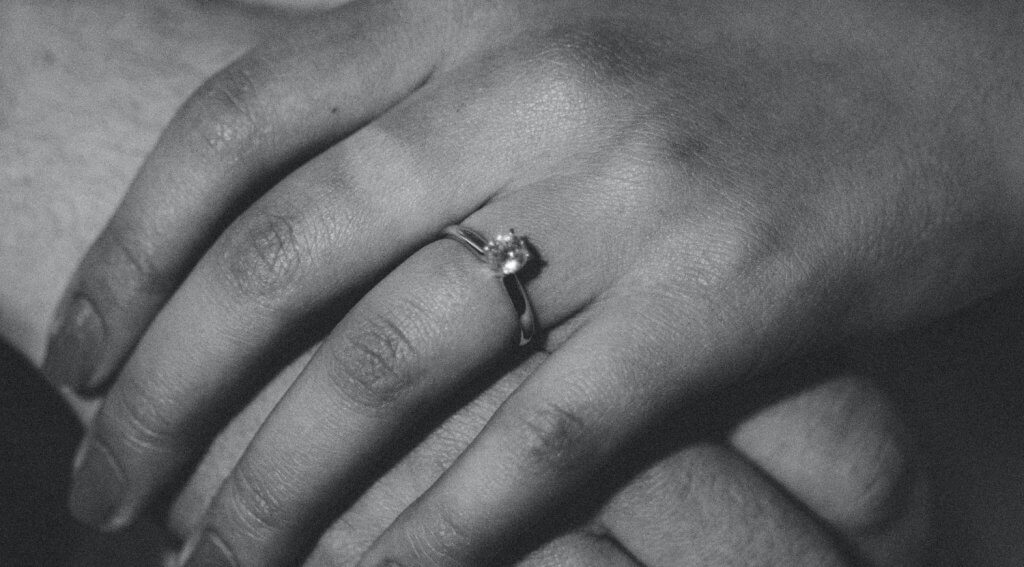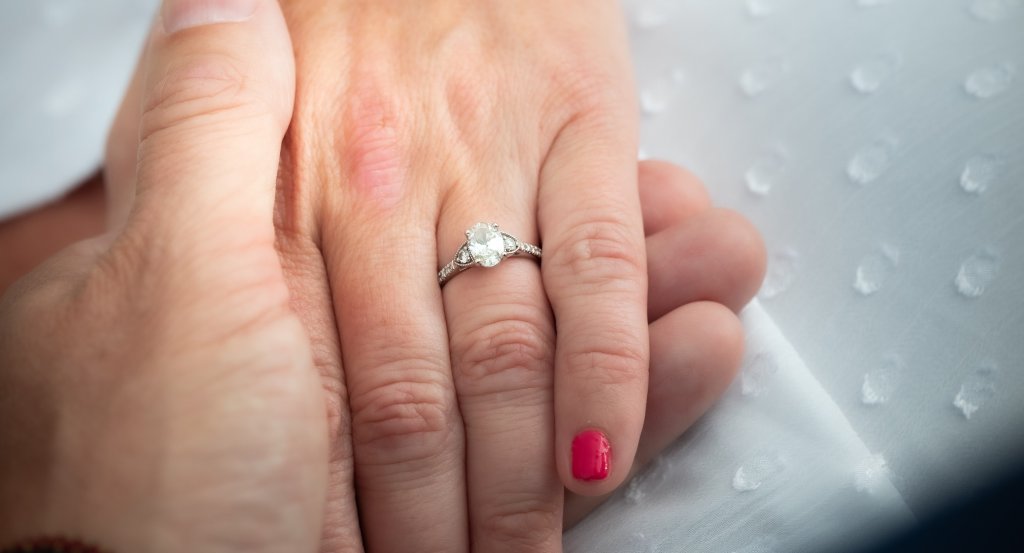The Bezel Setting: A Complete Guide
Key Takeaways
- The bezel setting breaks some of the ‘rules’ of engagement ring design, since it intentionally conceals a big portion of the diamond’s surface area.
- The bezel setting is a modern interpretation of an old design, encircling the diamond with a solid band, helping to emphasize the diamond’s beauty in a new and unique way.
- It has a beauty and a security that could be perfect depending on the lifestyle of your partner
- Make sure to take the bezel setting into account. It might be a new take on traditional designs, but it doesn’t step too far away. It could be the perfect choice for you.

While, for many shoppers, minimizing the impact their setting as on the diamond is a top priority, there is certainly something to be said for making a ‘statement’ with it instead. Gold and platinum are easily the most beautiful of all the precious metals, and incorporating them more into the design of the ring – rather than using them as sparingly as possible – is gaining popularity pretty fast.
Easily one of the most effective ways to make a statement with your precious metal is to opt for a bezel setting, which intentionally draws the eye not only to the diamond, but to that distinctive flash of gold or glint of platinum, too.
A great choice for anyone looking to make a statement, and go against the grain.
What is Bezel Setting in Jewelry?
A bezel simply refers to a slim, solid band of metal that surrounds the diamond.
Traditional, solitaire engagement rings utilize prong settings, which curl over the diamond’s edges in order to keep it secure without impeding on its light performance. The idea is to keep as much of the diamond exposed to the light as possible and, for that reason, has proven overwhelming popular throughout the years.
More recently, however, jewelers and shoppers have been looking to get a more modern spin on this design, and to offer alternatives.
By encircling the diamond within a solid band, the metal plays a much more prominent role in the overall design. Rather than overpowering the diamond, this rim can help it to ‘pop’ even more, while offering a very secure and practical setting for the gemstone.
A bezel may be used alongside a halo setting – a great option for smaller center stones, as it adds more sparkle back into the ring – or on its own for a more minimalist style.
What Is a Half Bezel Setting?
As the name suggests, the half bezel does not wrap all the way around the diamond. Instead, it may be used to border two corners or sides of the diamond, in order to give it more opportunity to let in light.
This is an excellent option for those who value the sleek, modern appearance of the bezel setting, but are afraid of ‘blocking’ too much of the diamond from the light. For this reason, it may be a good option to consider if your diamond is on the small side, or if there are some minor errors in the diamond’s cut that you would prefer to ‘mask’ with some clever use of the bezels.
Does a Bezel Setting Make a Diamond Look Larger?
The bezel setting does tend to make diamonds look a little smaller, since the edges of the diamonds are ‘clipped’ by the bezel, and it reflects a little less light.
However, every diamond reacts to this setting differently, so this is definitely a question worth posing to your jeweler if you’re struggling to decide between the bezel setting, or a more traditional pronged style.
Some diamonds can be enhanced by the bezel, particularly if they’re blemished or chipped, so don’t rule out this setting based on proportion alone.
If you’re working with a diamond that has a lower carat weight, or a three stone ring setting featuring smaller diamonds, then a half bezel setting could be your best bet. Still using this unique design, the half bezel will keep a portion of the diamonds’ edges exposed to the light, minimizing any ‘shrinkage’, and ensuring a great sparkle continues to play across the surface.
Do Bezel Set Diamonds Sparkle?
Yes – any natural diamonds will sparkle, although the bezel will put some limitations on the light traveling in and out of your diamond, meaning it won’t sparkle as much as a diamond held within a prong setting.
Don’t let this fool you, however. A good jeweler will know how to work design features around the unique attributes of any diamond, and will always tailor their approach to give it the most complementary setting possible.
Furthermore, the top of the diamond (also known as the table) boasts the largest surface area of the entire diamond, and the bezel setting does not intrude on any of the light that enters or exits the gemstone from above.
One thing to consider here is the diamond’s cut. Diamond cuts with the most sparkle might be better suited to the bezel setting, although a step cut diamond contained within a solid gold bezel can put a vintage spin on this elegant design.
In other words, don’t worry too much about sparkle. Your bezel set diamond will still play with the light beautifully, particularly if you have worked with your jeweler to find an excellent diamond in your price range.
Still, taking a look at these designs in person is very important before you commit to the style.
Is a Bezel Setting Secure?
Yes, the bezel makes the diamond incredibly secure – a great reason to choose this style if you’re worried about an expensive diamond working itself loose.
A full bezel is naturally more secure than a half-bezel but, either way, the unique way the metal ‘hugs’ the diamond means that it is very unlikely to shift or drop out of the ring.
Is a Bezel Setting More Expensive?
In general, yes. The bezel uses more metal and, since it needs to fit the shape of the diamond exactly, requires a greater level of skill than a more traditional prong setting.
A part of the cost of any diamond ring – or any piece of fine jewelry, for that matter – is the amount of expertise and time the jeweler put into crafting it. This is why the jeweler can never be replaced by the online store; the finished product is so dependent on the human behind it.
The create a perfect bezel setting, the jeweler needs to work hard to understand the unique shape and features of the diamond – to achieve the distinctive look of this design while still seeking to complement that particular gemstone in the best possible way.
And it is possible, and the results are spectacular, but they will come at a premium cost.
How Thick Should a Bezel Be?
There are no rules over bezel thickness, although you want it to be thick enough that it won’t be too vulnerable to damage. Many jewelers would recommend a thickness of 0.75-1mm, but bezels can be considerably thicker.
A thick bezel also offers more design opportunities. Some bezel settings might feature a number of smaller stones or intricate features along the outer edge, for instance, meaning there will be sparkle from every angle the ring might be viewed from when on the finger.
Does the Bezel Have to be Plain?
Not at all. Some bezels include intricate metalwork featuring beading, scalloping, or designs inspired by more organic shapes such as vines.
Decorative bezels can add a much more vintage feel to this setting style, proving quite how versatile it is. These designs will take considerably longer to draw up and create, but will prove more than worthwhile when your bride-to-be gets to see it for the first time – and, of course, a million times after that.
As we mentioned above, the bezel can also be paired with a halo of accent diamonds – something which may be worth considering if you love the bezel design, but don’t want to sacrifice a lot of sparkle. These smaller diamonds can encircle the bezel, or run around the outer edge, and ‘replenish’ any sparkle lost to the bezel setting – and some!
So, Why Choose a Bezel Setting?
The bezel setting makes a strong statement, and a strong impact. It offers a new, sleek, modern way to showcase a beautiful diamond, and to get the biggest impact out of the precious metals you choose to include within the design.
Furthermore, it’s a highly practical choice, offering the utmost security for your diamond. If your partner has a particularly demanding job or lifestyle, then the bezel could be the secret to finding the perfect ring for her – both in terms of beauty, and security. While prongs and exposed edges will occasionally snag on clothing, for instance, the bezel creates a more ‘streamlined’ shape that won’t catch so easily.
It is also a highly versatile setting, offering something different to every diamond cut it’s used on. It can bring out the incredible geometrics of step cuts like the Emerald, Asscher and Radiant, complementing those parallel lines with the bold platinum or golden lines of the bezels themselves. It can also, however, highlight the beauty of a round cut diamond, or the distinctive shape of a fancy cut, such as the Heart.
In other words, it’s a setting that brings something different to every diamond it’s used on. It’s different, and it’s modern, but it doesn’t stray too far from the more traditional designs, or work against the simple beauty of a well cut diamond.
We would highly recommend all shoppers to make a mental note of this design ahead of their consultation with their chosen jeweler.

Aug 17, 2021 By Willyou.net
The Ultimate Guide to Three Stone Settings

Mar 12, 2022 By Willyou.net
The Debate Continues: White or Yellow Gold for Diamonds?








